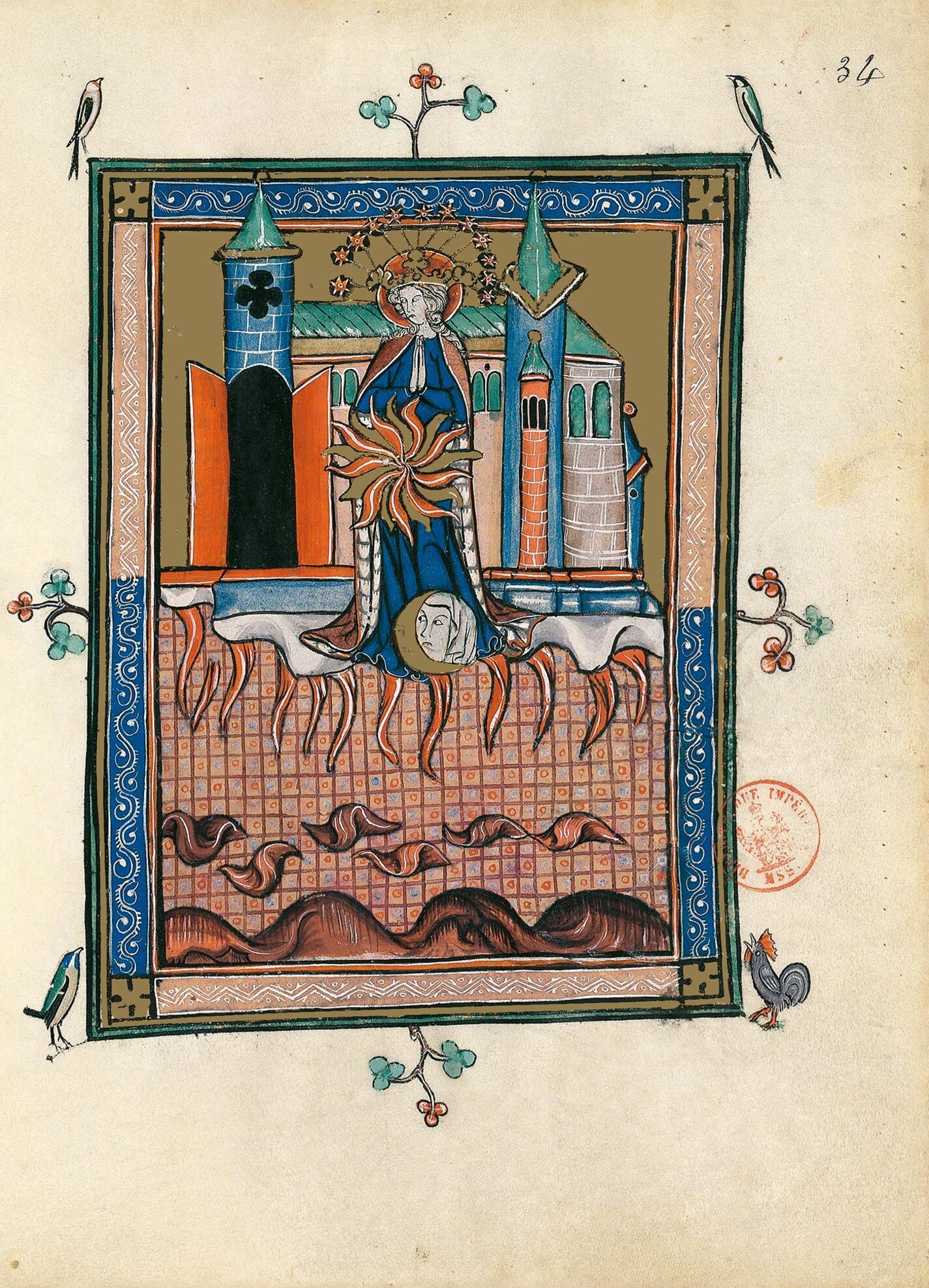“And the temple of God was opened in heaven: and the Ark of his Covenant was seen in his Temple.” The building, set upon the cloud, is depicted as a large church with towers and an apse with a double door wide open. The elements beneath quiver: flames rain down upon an undulating ground in motion whilst “the hailstones falling thick and fast” have been replaced by twisted clods of earth suspended in the air. This unusual image does not, however, distract attention from the main subject: the great sign in the middle of the composition, whose majesty contrasts with the turbulent elements. The Woman crowned with twelve stars and garbed in the sun stands tall in front of the Temple. Returning to the traditional interpretation of this chapter of the Apocalypse, the commentator deems it to represent an image of the Church surrounded by the twelve apostles. She is depicted here like a queen wearing a golden crown with a royal cloak lined with ermine upon her shoulders. At her feet is the moon, the symbol of the fickleness and futility of the people belonging to the world. Rather than wringing her hands in the pain of childbirth, this woman, whose role is “to bear the sons of God”, is posed in prayer. A flaming sun shines in front of “her womb” bearing “the seed of the Word of God”. The commentator says that the Ark of the Covenant is a symbol of Christ “in whom the Testaments Old and New are contained”. But the artist does not depict the Ark in the Temple, preferring the allegory of the sun, often used to symbolise the Saviour.
Marie-Thérèse Gousset and Marianne Besseyre
Illuminated Manuscripts Research Center, Bibliothèque nationale de France
Fragment of the Apocalypse of 1313 commentary volume

“And the temple of God was opened in heaven: and the Ark of his Covenant was seen in his Temple.” The building, set upon the cloud, is depicted as a large church with towers and an apse with a double door wide open. The elements beneath quiver: flames rain down upon an undulating ground in motion whilst “the hailstones falling thick and fast” have been replaced by twisted clods of earth suspended in the air. This unusual image does not, however, distract attention from the main subject: the great sign in the middle of the composition, whose majesty contrasts with the turbulent elements. The Woman crowned with twelve stars and garbed in the sun stands tall in front of the Temple. Returning to the traditional interpretation of this chapter of the Apocalypse, the commentator deems it to represent an image of the Church surrounded by the twelve apostles. She is depicted here like a queen wearing a golden crown with a royal cloak lined with ermine upon her shoulders. At her feet is the moon, the symbol of the fickleness and futility of the people belonging to the world. Rather than wringing her hands in the pain of childbirth, this woman, whose role is “to bear the sons of God”, is posed in prayer. A flaming sun shines in front of “her womb” bearing “the seed of the Word of God”. The commentator says that the Ark of the Covenant is a symbol of Christ “in whom the Testaments Old and New are contained”. But the artist does not depict the Ark in the Temple, preferring the allegory of the sun, often used to symbolise the Saviour.
Marie-Thérèse Gousset and Marianne Besseyre
Illuminated Manuscripts Research Center, Bibliothèque nationale de France
Fragment of the Apocalypse of 1313 commentary volume